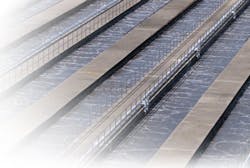By Jon Freedman
It’s no secret that water scarcity is a major global challenge. The frequency, severity and duration of droughts in places like California and Brazil have intensified in recent years. Water pollution is exacerbating the problem; meanwhile, the gap between water supply and demand is widening. Within the next 15 years, some analysts predict water demand could exceed supply by 40 percent.
As emerging markets continue to invest in their industrial sectors, many will experience increasing water supply shortages. In fact, industrial water use is expected to grow 250 percent by 2030, increasing industry’s share of global water use to nearly one-third. And if current trends persist, according to the Organization for Economic Cooperation and Development, the number of people subject to water stress will balloon from 1 billion today to over 3.9 billion by 2030.
Water Scarcity Challenge, Water Reuse Opportunity
Fortunately, the means - and the mission - to address water scarcity do exist today. The practice of water reuse allows communities and businesses to tap into an abundant resource - wastewater - with significantly less energy and expense than desalination. Defined as using water more than once before passing it back to the natural water cycle, reuse has emerged as a viable option to address water scarcity issues globally.
Though water reuse offers terrific promise for addressing water scarcity, today we only reuse about three to four percent of wastewater globally. The opportunity to grow reuse is great and we believe partnerships are a driving force of progress. Simply put, we can no longer be independent water users, and we can no longer face water challenges as individual actors. Continuous change to today’s approach to water management requires collective action - from organizations, governments and individuals.
GE has long believed in the promise of partnerships, and through our recently formed Ecomagination 2020 Partnership with global investment banking firm Goldman Sachs and MWH Global, a leading consulting and construction firm, we are proving its power. Together, we seek to implement reuse projects from beginning to end.
Advanced Water Reuse Technology and Solutions
Through a shared commitment to technology-focused reuse solutions, GE Water and its partners will advance energy-neutral wastewater, both direct and indirect reuse, and creative solutions that produce the new water and energy necessary to meet the expansion of our industries, cities, and growing populations.
For more than 100 years, water reuse technologies have been advancing to yield better and better results. Today, advanced chemistries and membrane-based systems can achieve 70-80 percent recovery of wastewater, while thermal evaporation, crystallization and biopolishing can achieve nearly 100 percent recovery. However, the processes have historically been energy-intensive, which has slowed the adoption of water reuse technologies.
As such, technology innovators are now focused on reducing the energy used in the treatment process - making the process more efficient and sustainable. Biological treatment is a prime example. The greatest demand for energy in biological wastewater treatment is providing oxygen to the system, which is typically achieved via forced bubble aeration. In fact, approximately 60 percent of the energy used at biological wastewater treatment facilities is for aeration. To achieve energy neutral wastewater treatment, facilities require a low energy treatment alternative to the conventional activated sludge process, as well as methods to enhance energy generation within existing infrastructure. Hybrid Membrane Aerated Biofilm Reactor (MABR) technology for biological treatment is an important emerging innovation.
Innovative new MABRs use a gas-transfer membrane to provide oxygen to bacteria. Low-pressure air from a blower is delivered to the top of each membrane. As the air travels down the inside of the hollow-fiber membrane, oxygen diffuses through the membrane where bacteria that grow in a biofilm on the outside of the membrane consume it. As wastewater passes through the bioreactor, the bacteria are supplied with the oxygen needed at an efficiency four times greater than conventional bubble aeration.
Design + Construction
Designing and building a wastewater treatment plant is highly variable from case to case due to differences in the needs of the population, regulation, emerging technologies, and available resources. Consider that 63 percent of all municipal effluent generated in the U.S. re-enters the water cycle and may become part of downstream drinking water sources. In fact, large U.S. cities such as Philadelphia, Nashville, Cincinnati, and New Orleans draw their drinking water from the Delaware, Cumberland, Ohio, and Mississippi Rivers, respectively, and can be counted among the populations served downstream of municipal effluent. The potable water in these de facto reuse locations meets drinking water standards because of the drinking water treatment technologies used; but it is important to note that in many locations impacted by de facto potable reuse, the degree of treatment and monitoring that wastewater-impacted source waters receive prior to entering the potable water supply is less than what is applied in planned potable reuse projects.
As part of its purpose “Building a Better World,” MWH Global places much emphasis on direct potable reuse implementation. In various capacities and for numerous projects, MWH Global and GE have collaborated for more than 20 years. There is a clear complementary partnership with the comprehensive offering of water treatment equipment and energy recovery systems from GE, coupled with the delivery portfolio of MWH that spans planning, engineering and design through construction and asset operation.
Alternative Financing
There is one fundamental challenge that communities and businesses face when considering water reuse projects: financing. As approximately 85 percent of the water and wastewater infrastructure in the U.S. is publically owned, federal grants, the municipal debt market and state revolving loan funds have served most of the financing needs for infrastructure investment. However, funding resources at federal, state, and local governments are becoming scarcer. In fact, according to the Environmental Protection Agency (EPA), the capital required to maintain and upgrade the U.S. drinking and wastewater systems in 2010 was $91 billion but only $36 billion of this was funded.
For fear of overburdening the aging water system, municipal water and wastewater utilities are increasingly seeking to partner with private sector participants through public-private partnerships (P3s). P3s can offer an added financing mechanism to complement traditional tax-exempt municipal bonds.
Carefully constructed P3s enable the municipal water utility to retain ownership and oversight while bringing private sector management of the water and wastewater assets. The private sector brings not only much needed capital to meet deferred investment but also the added benefit of operating expertise, innovative technologies, and economies of scale. There can be benefits from transferring certain risks to the private sector and harnessing the private sector’s expertise in managing maintenance and upgrades in an increasingly complex water and wastewater regulatory environment.
In the current market, where there are large pools of institutional investor capital looking for long-term yield, there is an opportunity to facilitate private capital to help fund these environmentally beneficial projects. Water investments offer a compelling alternative investment to clients as investing in water infrastructure can offer long-term regulated rates that are inflation-protected and less susceptible to economic cycles.
Goldman Sachs has long championed environmental projects. In 2005, it established its Environmental Policy Framework, articulating the importance of a healthy environment and leveraging its people, capital and ideas to address critical environmental issues. This framework, which was recently updated, helps to shape the firm’s corporate strategy to harness markets to address critical environmental issues - including water infrastructure. Leveraging its market know-how, Goldman Sachs seeks to facilitate private capital for much needed water infrastructure investments, including through P3s that bring the benefits of operational efficiency and economies of scale, facilitating rate stability and high-quality, long-term public water access.
Partnering for the Future
Severe drought affects more than a third of the U.S., often constraining operations and the economic performance in the impacted regions. Time and again, hurricanes and other natural disasters powerfully demonstrate that poorly maintained but vital water infrastructure is at risk. These are stark reminders of how precious our water resources are and highlight the pressing need to prioritize sustainable management of both.
GE’s Ecomagination program has shown that through more creative, collaborative partnerships among businesses, communities, NGOs and think tanks, we can protect our water supply and environment. As GE Chairman and CEO Jeff Immelt puts it: “The success of Ecomagination has proved that efficiency and economics go hand-in-hand.” It sounds simple, but the underlying call to action is anything but. Through this partnership, GE, MWH, and Goldman Sachs are answering that call.
About the Author: Jon Freedman is the global partnerships and government affairs leader for GE Water & Process Technologies.





